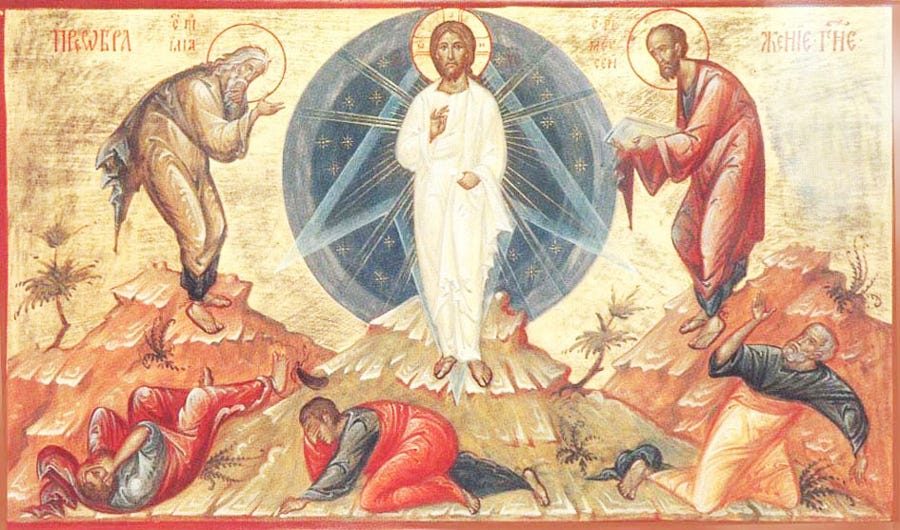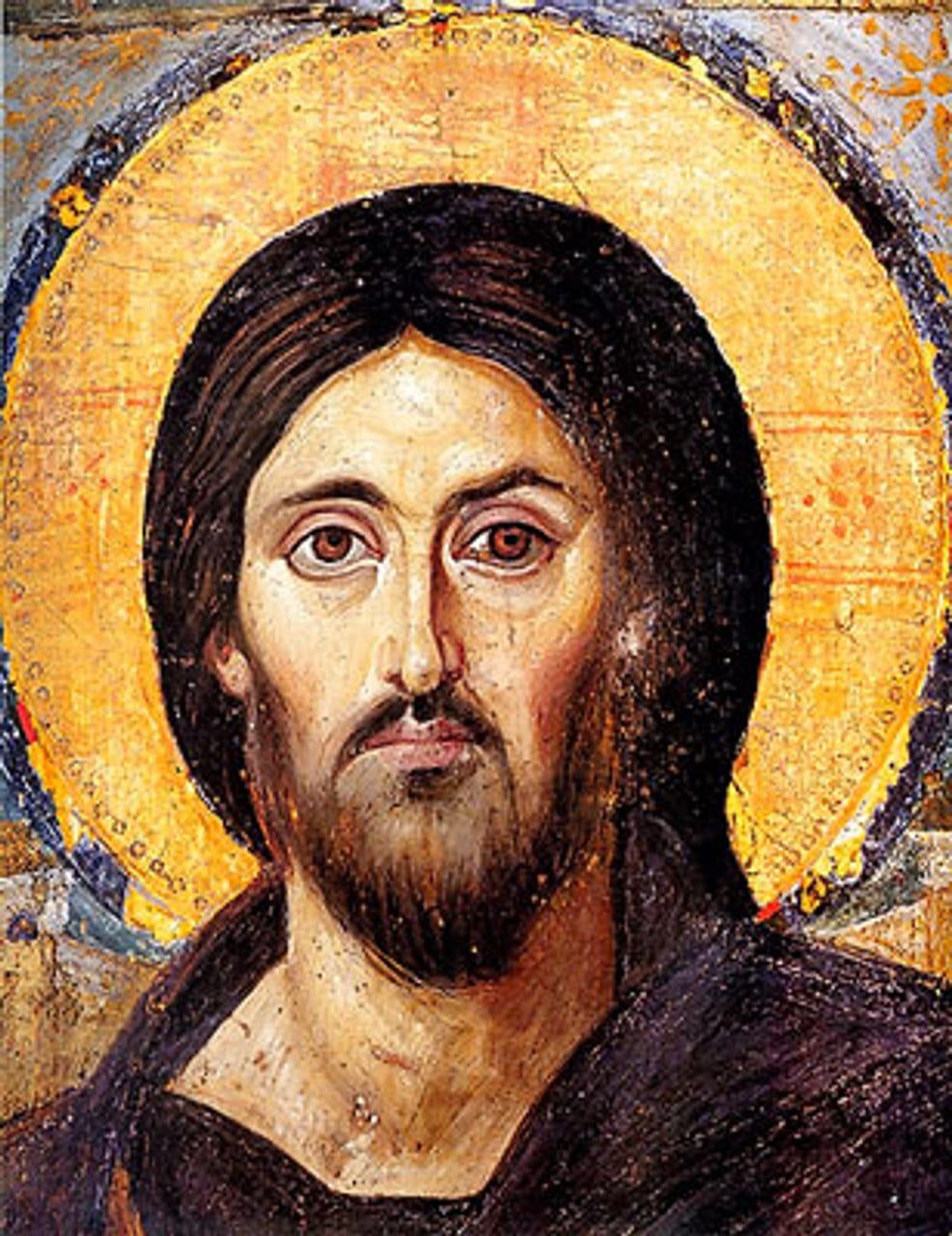A deeper dive: the Transfiguration icon and the ultimate goal of human life
Below the fold: a walk-through of the crypt of the Siena Duomo - rediscovered frescos!
After six days Jesus took with him Peter, James and John the brother of James, and led them up a high mountain by themselves. There he was transfigured before them. His face shone like the sun, and his clothes became as white as the light.
Matthew 17:1-2
And the Word became flesh and took up residence among us, and we saw his glory, glory as of the one and only from the Father, full of grace and truth.
John 1:14
“Christ was transfigured, then: not taking on what He was not, nor being changed to what He was not, but making what He was visible to his own disciples, opening their eyes and enabling them, who had been blind, to see.”
St. John of Damascus
There were some things about the Transfiguration icon that I wasn’t really able to get into in Thursday’s post. So today instead of the usual grab-bag of little things, I thought we could have an extra look at the meaning for us of this icon.
We’ll still have a paid section following this part that will include some more of my photos and video clips of our trip last month to Siena; today will be about the incredible lost cycle of medieval frescos that were rediscovered and restored in 1999. I hope you’ll consider subscribing to join us in our ongoing exploration of these ancient artistic wonders.
The Sacred Images Project is a reader-supported publication where we talk about Christian sacred art, the first 1200 years. It’s my full time job, but it’s still not bringing a full time income, so I can’t yet provide all the things I want to and am planning for. You can subscribe for free to get one and a half posts a week.
For $9/month you also get the second half of the Goodie Bag, plus a weekly paywalled in-depth article on this great sacred patrimony, plus extras like downloadable exclusive images, ebooks, mini-courses, photos, videos and podcasts (in the works).
If you would prefer to set up a recurring donation in an amount of your choice, or make a one-off contribution, you can do that at my studio blog:
Some time ago we examined the great Sinai Pantocrator and the theological implications of this image.
All true Christians accept the doctrine that Christ is fully man and fully divine, that He is one person with two natures, but this has not come without a great deal of struggle, and in many ways it is a struggle that continues today. In our art, especially, the emphasis in the west is mainly on the human, natural aspect of Christ’s person, reflecting our 500 year devotion to Naturalism and Humanism in philosophy…
The Pantocrator iconographic prototype is about the highest Christology you can get: Christ the universal judge and king, the ruler of everything, for whom and through whom all things were made, of one substance with the Father…
But the Pantocrator isn’t the only icon that is specifically intended to convey the indescribable majesty of Christ. The Transfiguration has the added bonus that it points not only to the reality of the Divinity of Christ, but toward our own, potentially. The Transfiguration is a foretaste of theosis, Christ's divine nature revealed to the disciples, showing them what is possible for humanity.
Theosis: the transformative process by which a person becomes more like God, participating in His divine nature. It is the ultimate goal of human life, where through God's grace and cooperation with the Holy Spirit, a person is sanctified and united with God - as it is put by Byzantine theologians, sharing in His “uncreated energies,” particularly His light, love, and holiness. Theosis does not imply becoming God in essence but rather partaking in the divine life as far as it is possible for a human being, reaching full potential in communion with Him.
I’m not a Byzantine Christian, I’m a western, Latin Christian and that makes me more verbal than visual, so my first instinct isn’t to go for the images, but the words when I want to know what something means. But since starting to study these icons and the iconographic, eastern Christian mind, I’m starting to put the two sides together more. As I was writing our all-subscribers’ post yesterday about the icon of the Transfiguration, I was reading a book sent to me by a Melkite Catholic friend, called the Publican’s Prayer Book that has a full set of liturgical Byzantine prayers for this feast. There’s a lot in here that tells us what it all means.
Some of the prayers for the feast:
“Addressing to His friends the words of life concerning the Kingdom of God, Christ said to them: When I shine with Unapproachable Light, you shall know that the Father is in Me…
… for you will be filled with glory and shout for joy; Let us sing to our God, for He is gloriously triumphant!”
“Today as He promised, Christ, shining on Mount Tabor, dimly discloses to His disciples the refulgence of His Divine and Light-Bearing Splendour; and, filled with that Godly Light, they cried out for joy: Let us sing to our God, for He is gloriously triumphant!”
The Transfiguration is there to tell us that this business about being filled with glory and filled with the Unapproachable Light isn’t metaphorical. He really means it; our life’s goal, ordained by God, is to be transfigured as He was transfigured. We are to be changed in the way that He was changed before the eyes of the three disciples.
Here’s the thing to remember: this really happened. It was recorded in three of the four Gospels and it has been recorded visually in this icon since the earliest times:
Christ is depicted at the centre, often within a mandorla (an almond-shaped or geometric aureole representing the divine light breaking through from heaven into this world), symbolizing the divine light or uncreated light. The figures of Moses and Elijah are shown on either side of Him, and the three apostles are depicted below them, usually smaller in scale, and knocked off their feet, in postures of abjection, fear and awe. The use of gold leaf for the background also symbolises the eternal and unchanging light of Divinity.
Why Peter, James and John? Why Moses and Elijah?
There’s a lot more to it than I could fit into this post. There’s more in it than there is in this video, but it will give you a good idea of the layers and depths.
This icon is not merely a historical depiction; it is a theological statement about the nature of our relationship with God and His ultimate plans for us. The emphasis on light, particularly the Uncreated Light emanating from Christ, is crucial. This light is not just physical but is understood to be what Byzantine theologians call the “divine energy,” the energy which transforms us.
And the prayers of the feast in the east make this explicit: this is the same energy that created everything; the flames out of which God spoke to Moses, that barred the passage of the Egyptian Pharaoh from the Israelites, the energy that came down and guided them through the desert; the same energy is bestowed on us in the process of theosis.
It is, as Tolkien put it, the “secret fire,” the “Flame Imperishable” - “And the sight of the glory of the Lord was like a burning fire upon the top of the mount, in the eyes of the children of Israel.” (Exodus 24:17)
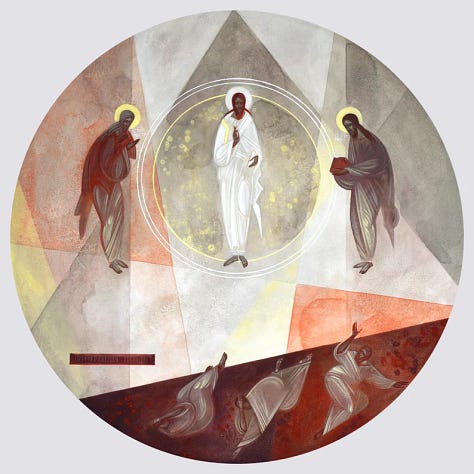
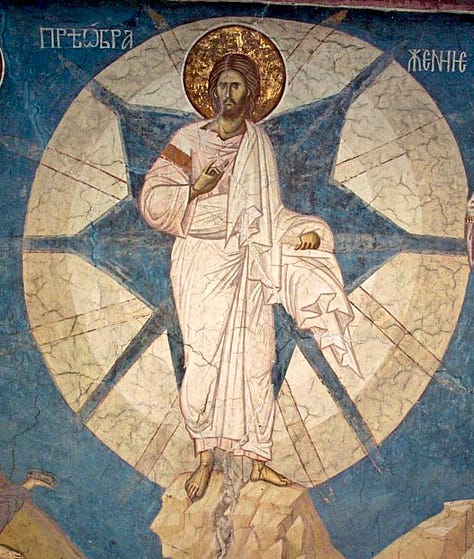
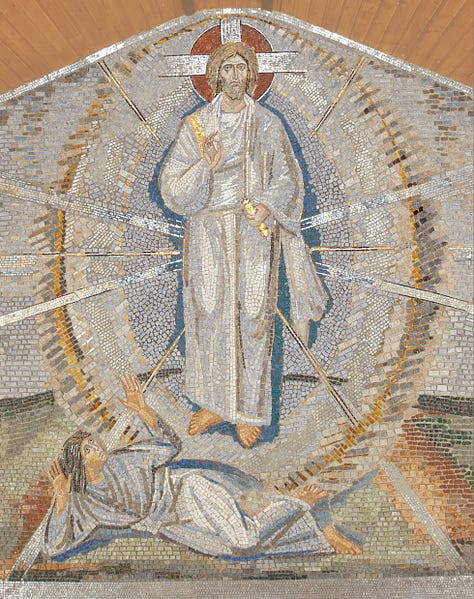
The Transfiguration not just as a historical event but a mystical reality that every believer is called to experience. The icon invites the faithful to enter into the mystery of Christ's divine light, the same light they are called to partake in through theosis.
Benedictine Book Club
Our paid members, however, are invited again to join us for our ongoing discussion in the Substack chat of Abbess Cecile Bruyere’s book, “The Spiritual Life and Prayer According to Holy Scripture and Monastic Tradition.” We are exploring what is really meant by prayer in the contemplative sense, how to pursue it and what it all means.
I’ll be restarting a new thread at the start of each week, and that will be sent out to paid members via email to make it easy to find. One click.
Subscribe to join us.
Below, we’ll take a walk together around the ancient crypt church of the Siena Duomo - walled up and forgotten for 650 years…


